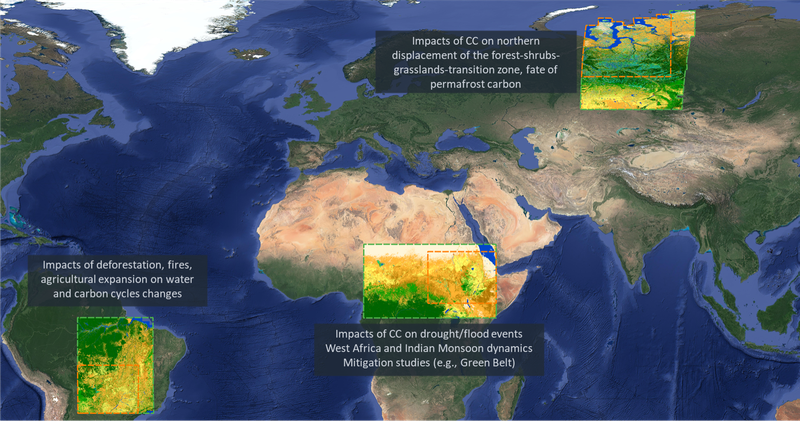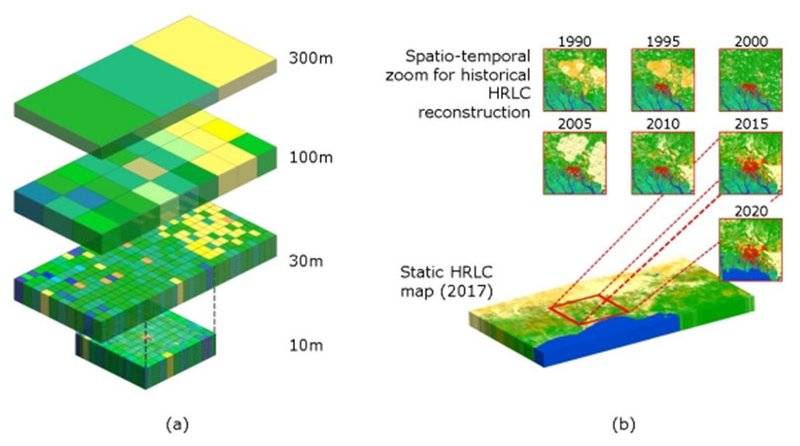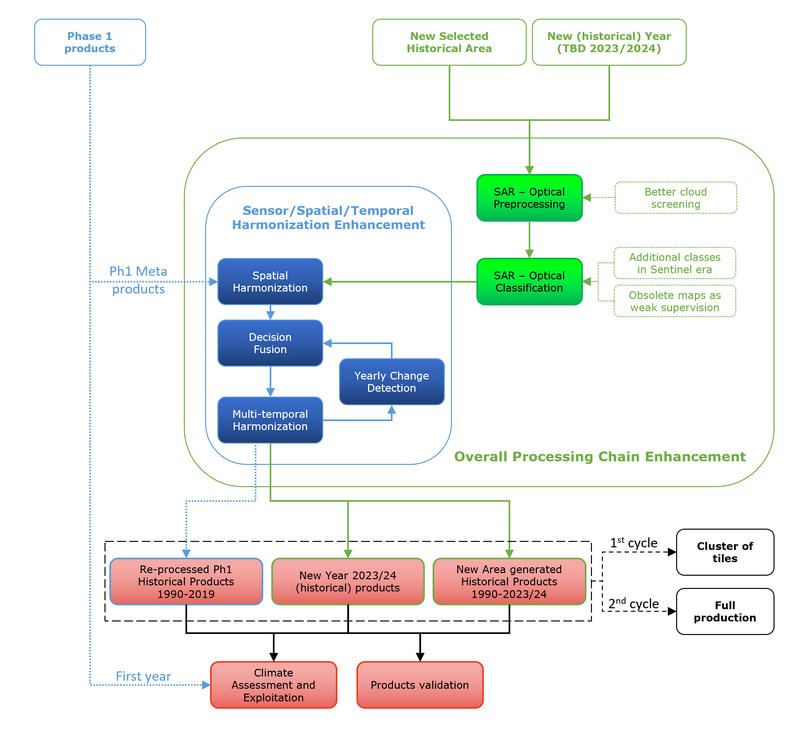About
The High Resolution (HR) Land Cover (LC) Essential Climate Variable (ECV) project involves the accurate description and analysis of land cover (LC) and land cover change (LCC) using Earth Observation (EO) data with high spatial resolution (10-30m), with the primary objective of examining the role of the spatial resolution of the detected changes to support climate modelling research. LC change is in fact both a cause and a consequence of climate change either when the change is human-induced or generated from natural events.
Land Cover has a key role on surface energy, water and carbon fluxes variables. Moreover, LCC has an impact on radiative (albedo), aerodynamic, evaporative properties, carbon storage with different effects on surface temperature and precipitation. These factors have been taken into account by the climate modelling community to properly model Earth climate at a global scale using medium resolution EO data (i.e., 100m).
However, improvement of sensor technology achieved during the last decade makes EO data with high spatial resolution available. For these reasons, HR_LandCover_CCI will produce LC and LCC maps with high spatial resolution and investigate their impact and the crucial role of spatial resolution on climate models at regional scale.
The project will focus primarily on three subcontinetal regions and sub-regions within them:
- South America (Amazon forest);
- West Africa (Sahel band);
- Western Siberia;
- New areas under evaluation.

Objective
The primary objective of HR_LandCover_CCI is to study and investigate the role of the spatial resolution of LC and LCC in supporting climate modelling research at regional scale. HR_LandCover_CCI aims at improving the understanding of the interaction between climate and land cover while increasing the spatial resolution of 1 order of magnitude (from 300m to 10-30m) with respect to the LandCover_CCI.
About the project
Land cover (LC) is defined by FAO as the observed physical cover of the Earth surface. It includes the vegetation and human-made infrastructures, like water, ice, rock, forest or urban areas. Its assessment and the monitoring of its dynamics are of extreme importance for the correct estimation of Earth radiation budget. Moreover, LC is correlated to land use and by proxy allows the study of how human activities impact on the Climate.
CCI+ aims at the cooperation between climate modelers, EO communities and industrial partners on the development of software systems for the pre-operational ECV production in a research context.
During the three years of the programme, the Consortium will generate and validate LC maps and LCC using EO data acquired over the last decades and continuously acquired today. This will enable the study of LC and LCC and their impact on Earth Climate at regional scale using high spatial resolution EO data (i.e., 10-30m). Indeed, with the evolution of technology, a higher spatial resolution and an increased operational availability of EO satellite data make it possible to overcome several limitations of LC mapping. The HR_LandCover_CCI variable is crucial for improving our understanding in relation to climate modelling and mitigation/adaptation strategies.
The primary objectives are:
- Examining the role of the spatial resolution to support climate research;
- Studying LCC in key regions exposed to extreme climate conditions or characterized by significant climate changes over the last decades;
- Understanding classification variability across spatio-temporal scales.
The EO products:
- HRLC10: High Resolution Land Cover Maps at 10m spatial resolution for year 2019 (also referred to as static maps) at subcontinental scale for 2019;
- HRLC30: High Resolution Land Cover Maps at 30m spatial resolution for years 1990, 1995, 2000, 2005, 2010, 2015, 2019 (also referred to as historical maps) in sub-regions of HRLC10;
- HRLCC30: High Resolution Land Cover Change Maps at 30m spatial resolution of yearly changes. A map every 5 years (1990-1995, 1995-2000, 2000-2005, 2005-2010, 2010-2015,2015-2019) is provided which reports (high priority) changed pixels and their year.

HR_LandCover_CCI will keep spatio-temporal consistency with respect to the CCI Medium Resolution (MR) Land Cover. Several new challenges should be addressed that concerns EO science, validation, engineering and climate modelling. In particular, challenges related to the Climate studies are:
- Improvement of the land cover description by refining the relationships between LC classes and Plant Functional Types especially for mixed species classes;
- Improvement of how LC and LCC influence the energy, water, carbon (CO2, CH4) budgets;
- Improvement of the understanding of surface-atmosphere interactions and climate change impacts on vegetation (e.g., in regions where climate warming already impacts vegetation, like greening in Arctic);
- Better evaluation of the LCC impacts on the climate to support climate mitigation/adaptation policies at regional and local levels.
Challenges and novelty related to EO Science consist of:
- The use of HR data available in the past/current archives at a larger temporal interval and stronger variability across the years with respect to MR data;
- The shift of the processing paradigm from the analysis of many MR images per year to the processing of (very) few images per year characterized by HR;
- The systematic use of multi-sensor data to fill the temporal gaps in data availability and to address cloud cover issues;
- The spatio-temporal consistency with CCI MRLC results.
High quality results will be guaranteed by several validation activities:
- Independent accuracy assessment based on the quantification of accuracy and on the disentanglement of the different uncertainties characterizing the HRLC deliverables;
- Intercomparison analysis in order to compare existing HRLC products and the ones delivered by the Consortium;
- The assessment of the impact of HR on climate models.
Coming next
- Historical products re-processing: generation of an improved version of historical products by enhanced sensor decision fusion and spatial and temporal harmonization.
- Historical production on a new selected area.
- Historical (forward) production of year 2023 (or 2024) for all the considered areas: the forward production of the year 2023 (or 2024) will be performed in the Sentinel Era, characterized by a 10m spatial resolution and a high availability of satellite image data.


